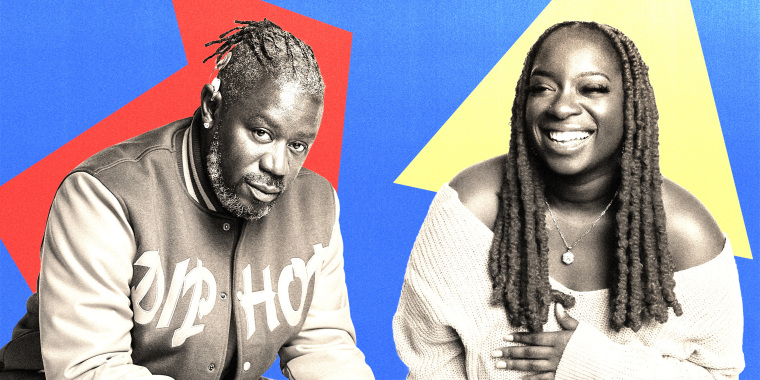By now, you’ve likely seen a viral video of an American Sign Language interpreter borrowing the limelight from a musician during a concert.
The performances go beyond what many hearing people may understand as signing, leaning into dance and exaggerated facial expressions to more fully capture a song’s essence. These animated, visual personifications of music lend themselves to virality.
The overdue proliferation of ASL interpreters at concerts underscores the critical need for accessibility. (After all, about 11 million people in the United States identify as deaf or have difficulty hearing.) It also unravels myths about the deaf community’s relationship with music.
Raven Sutton, a deaf ASL performer, set the record straight on that subject when I spoke with her last month.
“People are always like, ‘Oh, deaf folks don’t like music. Why are they at a concert?’ We do,” Sutton, the first deaf contestant on Netflix’s “The Circle,” said through an interpreter.
For deaf people, music is a kind of sensory experience that often requires visualization through sign language and feeling the vibrations of sounds. It’s one that Sutton, also known as Deaf Hottie, is well versed in.
It’s the 21st century, and the time is now for total inclusion.
Warren "Wawa" Snipe
Sutton does ASL covers of hip-hop and R&B songs on her YouTube channel and has performed alongside a number of renowned hip-hop artists, including Megan Thee Stallion and Jermaine Dupri. Her ASL cover of Cardi B and Megan Thee Stallion’s “WAP” has more than 74,000 views on YouTube.
She described the extensive preparation that goes into her performances.
“You’re not just taking it [the song] at face value,” she said. “ASL is not English. So what is said in English, you have to turn it into ASL.”
Sentences in ASL, inspired in part by French Sign Language, are structured differently from those in English.
“I actually have to memorize the English lyrics, then translate that into ASL lyrics, and then interpret that and memorize that interpretation,” Sutton said. “Then I memorize the beat of the song and I have to get down to what the artist is trying to say.”
“[Hearing] people can just listen to lyrics, incidentally, as they’re washing dishes and memorize what it is,” she continued. “But for me, as someone who’s deaf, I really have to study.”
And that’s just prior to a performance.
Artists sometimes stray from the recorded version of a song during concerts, which can make real-time interpretations difficult. That’s where “feeders” come in. Feeders aren’t deaf and can relay to an interpreter if there has been a change in the chronology or pacing of a song.
In other words, there’s a lot to take into consideration. But Sutton is making it work, and it helps that she has people like dip hop creator Warren “Wawa” Snipe to look up to.
Dip hop is a musical style inspired by hip-hop and tailored for the deaf community through ASL and videos that feature lyrics on the screen. Snipe, a Philadelphia native, has described the genre as “Hip Hop through deaf eyes.”
Dip hop isn’t ASL covers of hip-hop songs. It’s original music and lyricism, in the style of hip-hop, made by deaf artists.
Snipe and his DJ perform under the moniker Wawa’s World. His music videos on YouTube all feature ASL and on-screen lyrics, and they've garnered tens of thousands of views.
But music didn’t always come easy for Snipe. As a child, it took weeks, sometimes months, for him to learn a song.
“My sister would help me,” Snipe told me in June. “She would write the lyrics, I would lip-read, and I would have my hand on the speaker. … I trained myself to identify the rhythm.”
Snipe was born deaf, though he didn’t learn ASL until he was in college, he told me through an interpreter.
“It was a second birth for me,” he said. “I’m not the last person to know everything anymore.”
It was also in college that Snipe took his knowledge of ASL a step further by performing dip hop at a dorm party in 1991. But it didn’t catch on right away.
“When I introduced it, deaf people were not ready for that kind of thing,” he said. “They didn’t identify that as music.”
If the criticism sounds familiar, that’s because hip-hop’s detractors also lamented that rap didn’t qualify as music when it first gained mainstream popularity.
Feeling discouraged, Snipe left dip hop behind until about a decade later, when he saw Sean Forbes, another deaf rapper, doing a cover of a rap song.
“People were like, ‘Oh, you were already doing that before,’” he said. “That passion came back again.”
As with hip-hop, dip hop persisted. Snipe now has three albums under his belt.
As part of his mission to make music more inclusive, he mentors and collaborates with other dip hop artists — and spurns the misogynistic reputation hip-hop has earned. In his song “Only ASL One,” which has amassed over 30,000 YouTube views, he raps about his affections for a woman who’s also deaf.
“Degrading women, that’s not me,” Snipe said.
His dream is for dip hop to be featured at a Super Bowl halftime show. He’s halfway there: He performed the national anthem in ASL at the Super Bowl in 2021.
He remains focused on making his music, and hip-hop generally, accessible to the masses.
“It’s the 21st century,” he said, “and the time is now for total inclusion.”
This post is part of MSNBC’s “Hip-Hop Is Universal” series, which celebrates the genre’s 50th anniversary and examines its future.
